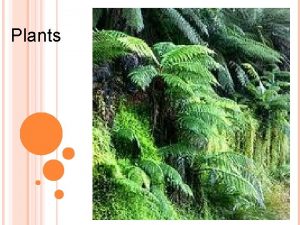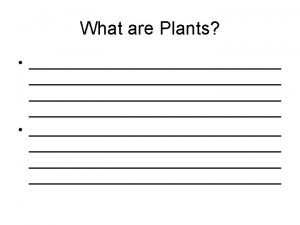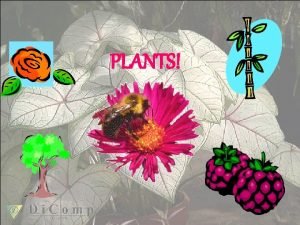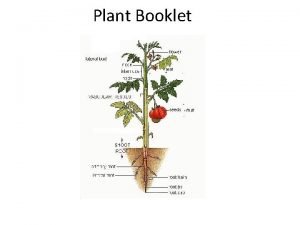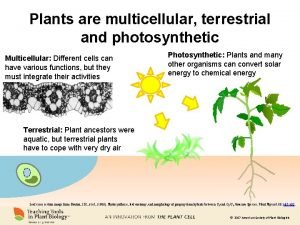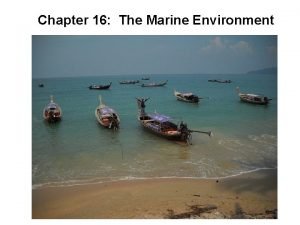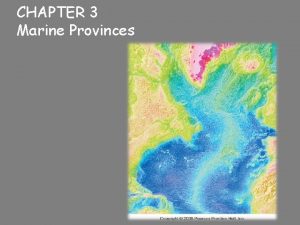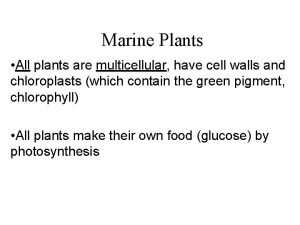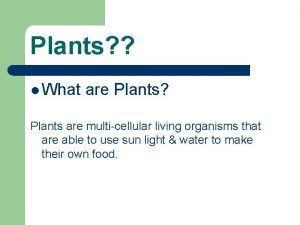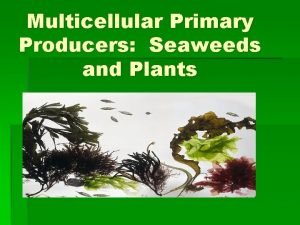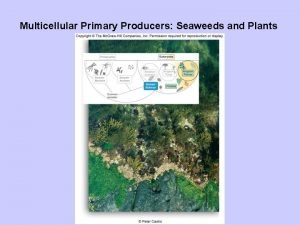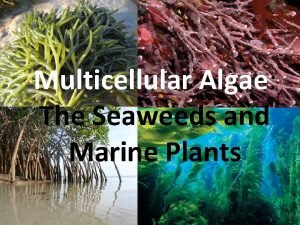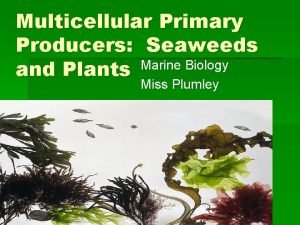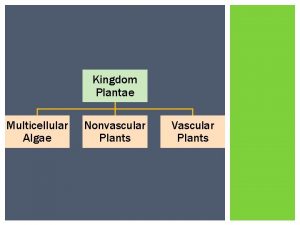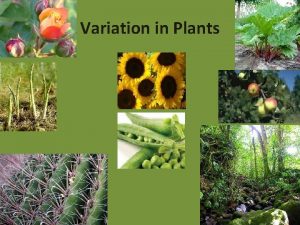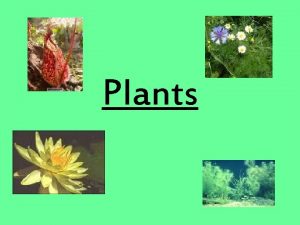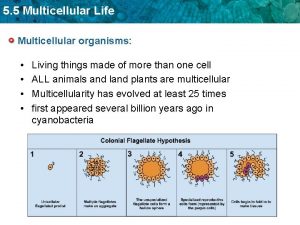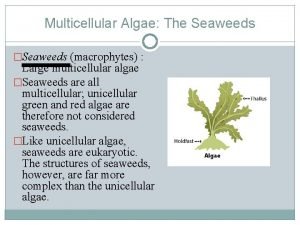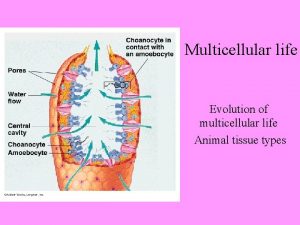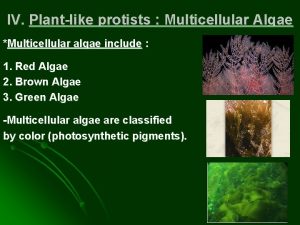Chapter 4 Marine Plants Multicellular plants in the




























- Slides: 28

Chapter 4 Marine Plants Multicellular plants in the sea are dominated by brown and red algae, with green algae and some flowering plants also playing important roles. Copyright © 2004 Jones and Bartlett Publishers

Chapter 4

Chapter 4 Division Anthophyta • Submerged Seagrasses – About 50 species of seagrasses thrive throughout the world along subtidal softbottom shorelines. Most seagrasses reproduce vegetatively via horizontal rhizomes or sexually via underwater pollination of tiny flowers followed by fruit production.

Chapter 4 Division Anthophyta • Submerged Seagrasses a b Fig. 4. 2 Three common seagrasses from different marine climatic regions: (a) turtle grass, Thalassia; (b) eel grass, Zostera; and (c) surf grass, Phyllospadix. c

Chapter 4 Division Anthophyta • Emergent Flowering Plants – Additional flowering plants, such as marsh grasses and mangals, grow on soft bottoms in the intertidal zone. All types of marine flowering plants host a unique community of organisms within the habitat they create.

Chapter 4 Division Anthophyta • Emergent Flowering Plants Fig. 4. 3 Dense mangal thicket lining a tidal channel (Courtesy of NOAA).

Chapter 4 The Seaweeds • Structural Features of Seaweeds – Most large conspicuous plants in the sea are macroalgae (seaweeds and kelps), growing from rocky substrates with their characteristic blades, stipes, holdfasts, and pneumatocysts (in some species).

Chapter 4 The Seaweeds • Structural Features of Seaweeds Fig. 4 The northern sea palm Postelsia (Phaeophyta) is equipped with a relatively large stipe and a massive holdfast.

Chapter 4 The Seaweeds • Structural Features of Seaweeds Fig. 4. 7 Some large kelp plants of temperate coasts. Each mature plant develops from a young plant with a single flat blade.

Chapter 4 The Seaweeds • Photosynthetic Pigments – The common names of seaweeds often are motivated by their colors, which in turn reflect the various photosynthetic pigments that they contain.

Chapter 4 The Seaweeds • Photosynthetic Pigments – Color appearance of Chlorophyta Fig. 4. 12 Intertidal rocks covered with the green alga, Ulva (Courtesy of G. Dudley).

Chapter 4 The Seaweeds • Photosynthetic Pigments – Color appearance of Phaeophyta Fig. 4. 13 The brown alga, Fucus, from a rocky intertidal

Chapter 4 The Seaweeds • Photosynthetic Pigments – Color appearance of Rhodophyta Fig. 4. 14 Mixture of calcareous red algae growing on intertidal mussels. (Courtesy of G. Dudley).

Chapter 4 The Seaweeds • Reproduction and Growth – Reproduction in seaweeds can be either vegetative and asexual or complex and sexual. – Sexual reproduction tends to follow three fundamental patterns, all variations of alternating sporophyte, gametophyte, and/or carposporophyte generations.

Chapter 4 The Seaweeds • Reproduction and Growth Fig 4. 16 The life cycle of Laminaria (similar to the cycles of other large kelps), alternates between large diploid sporophyte and microscopic haploid gametophyte.

The Seaweeds Chapter 4 • Reproductio n and Growth Fig 4. 17 Generalized growth pattern of a kelp. Punched holes and blue lines indicate the pattern of blade elongation. Adapted from Mann, 1973.

Chapter 4 Geographic Distribution • A complex interplay of physical, chemical, geologic, and biologic factors determine the distribution of marine plants on both local and global scales. • In general, brown algae are better adapted to cooler waters, red algae to warmer waters.

Chapter 4 Seasonal Patterns of Marine Primary Production • Fig. 4. 20 The seasonal variation of light intensity at the sea surface sets in motion a cascading series of changes in the photic zone.

Chapter 4 Seasonal Patterns of Marine Primary Production • Temperate Seas – A diatom bloom during the spring, followed by the successional appearance of lessnumerous dinophytes during the summer, is the prominent scenario of production in temperate seas.

Chapter 4 Seasonal Patterns of Marine Primary Production • Temperate Seas Fig. 4. 21 Seasonal fluctuations in the major features of a temperate water marine primary production system.

Chapter 4 Seasonal Patterns of Marine Primary Production • Warm Seas – Tropical and subtropical waters exist in eternal stratification, with low rates of production and year-round plankton communities that resemble those of temperate regions during summer months.

Chapter 4 Seasonal Patterns of Marine Primary Production • Warm Seas Fig. 4. 23 Comparison of the general patterns of seasonal variations in primary productivity for four different marine production systems.

Chapter 4 Seasonal Patterns of Marine Primary Production • Coastal Upwelling – Rates of net primary production in areas of coastal upwelling are among the highest in the sea, but they are very limited in geographic extent and some of the most important ones are interrupted by El Niño events.

Chapter 4 Seasonal Patterns of Marine Primary Production • Coastal Upwelling Fig. 4. 24 Sea. Wi. FS image of chlorophyll a concentrations in the upwelling area of the California Current (left) and the Benguela Current off South Africa and Namibia.

Chapter 4 Seasonal Patterns of Marine Primary Production • Polar Seas – The seasonal formation and melting of sea ice and tremendous variations in availability of sunlight greatly influences production in polar seas, yet photosynthesis can continue around the clock during a few summer months to create dense populations of phytoplankton.

Chapter 4 Global Marine Primary Production • Spatial variations in primary production are common, with mid- and high-latitude regions, shallow coastal areas, and upwelling zones being the most prolific, but only during warm summer months when sufficient sunlight is available.

Global Marine Primary Production Chapter 4 • Fig. 4. 26 Geographic variation of marine primary production made from over three years of data. (Courtesy of Gene Felderman, NASA/GSFC Space Data Computing Division. )

Chapter 4 Global Marine Primary Production
 Are plants multicellular
Are plants multicellular Plants are multicellular eukaryotes
Plants are multicellular eukaryotes Multicellular plant
Multicellular plant Plant tissue
Plant tissue Are plants multicellular eukaryotes
Are plants multicellular eukaryotes Photosynthetic multicellular and terrestrial kingdom
Photosynthetic multicellular and terrestrial kingdom Plants are multicellular
Plants are multicellular Are plants multicellular eukaryotes
Are plants multicellular eukaryotes Vascular vs nonvascular plants
Vascular vs nonvascular plants Nonvascular plants reproduction
Nonvascular plants reproduction Classify the non flowering plants with examples
Classify the non flowering plants with examples C3 plant
C3 plant Chapter 16 the marine environment
Chapter 16 the marine environment Marine science chapter 1
Marine science chapter 1 Precision depth recorder
Precision depth recorder Hình ảnh bộ gõ cơ thể búng tay
Hình ảnh bộ gõ cơ thể búng tay Lp html
Lp html Bổ thể
Bổ thể Tỉ lệ cơ thể trẻ em
Tỉ lệ cơ thể trẻ em Chó sói
Chó sói Glasgow thang điểm
Glasgow thang điểm Chúa yêu trần thế
Chúa yêu trần thế Các môn thể thao bắt đầu bằng tiếng đua
Các môn thể thao bắt đầu bằng tiếng đua Thế nào là hệ số cao nhất
Thế nào là hệ số cao nhất Các châu lục và đại dương trên thế giới
Các châu lục và đại dương trên thế giới Công thức tính thế năng
Công thức tính thế năng Trời xanh đây là của chúng ta thể thơ
Trời xanh đây là của chúng ta thể thơ Mật thư tọa độ 5x5
Mật thư tọa độ 5x5 Phép trừ bù
Phép trừ bù
